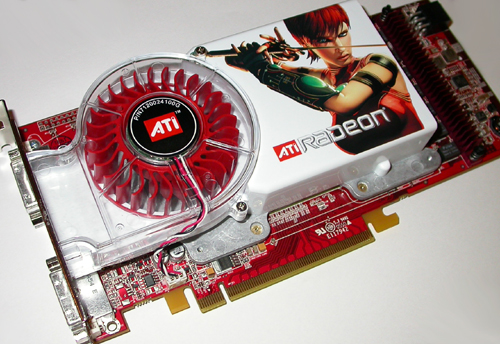X1900 XT/XTX Roundup: A Closer Look at the Performance Leader in Graphics
by Josh Venning on February 15, 2006 4:00 PM EST- Posted in
- GPUs
PowerColor X1900 XT
The last part that we have for review is another X1900 XT from PowerColor. As with the GeCube X1900, the appearance of this card is identical to ATI's reference X1900 XT, which also looks exactly like the reference X1900 XTX. The fact that these cards look identical made telling them apart a bit of a headache, and we wish PowerColor and GeCube could have at least slapped their logo on the HSF before shipping them out.
The last part that we have for review is another X1900 XT from PowerColor. As with the GeCube X1900, the appearance of this card is identical to ATI's reference X1900 XT, which also looks exactly like the reference X1900 XTX. The fact that these cards look identical made telling them apart a bit of a headache, and we wish PowerColor and GeCube could have at least slapped their logo on the HSF before shipping them out.











25 Comments
View All Comments
rizki0309 - Thursday, February 16, 2006 - link
Just Upgrade My Mobo and VGA to from 9800Pro X1900XT Bought for US$620 Yeeeek!!!.... My Eyes oh my eyes is satisfied.... But My EAAAAR.... Ziiiiiiiiing!!!! Those Damn Noise Kill my Audiophile Speakers....the Chase - Wednesday, February 15, 2006 - link
Hope I didn't miss it in the article but just curious if you did use the 6.2's(I'm sure you did). Also I could easily bring one of these cards to its knees at 1280x960. I think everyone would game with maximum eye candy if their video would let them.ajtyeh - Wednesday, February 15, 2006 - link
and really games with the highest eye candy settings on...seriously
BenSkywalker - Wednesday, February 15, 2006 - link
My screen supports 2048x1536@85Hz- and there are a lot of others that frequent AT that grabbed a 2070/2141(over 1600x1200 is the norm amongst the high end video enthusiast where the 2405, FW900 and 2070/2141 dominate).Nice roundup Josh, covered all of the important elements for the various boards.
WooDaddy - Friday, February 17, 2006 - link
No really...Josh, What kind of monitor were you using to test? These resolutions are getting crazy now. It's nice to know they can support that hires with that speed, but what about the display? Which one did you use.
I'd imagine the rest of us prolly run at 1280, maybe 1600 with a 19" LCD.
yacoub - Wednesday, February 15, 2006 - link
Bullcrap. That's not at all what your posted results show. It shows it to be just as noisy as the others. Which is a shame considering most of us would LOVE to see some quieter X1900XT cooling solutions offered stock. Where is Sapphire to step up with such an offering? They did with the X800XL (in 256MB and 512MB versions). Gigabyte did it with the 7800GT 256MB.
sri2000 - Wednesday, February 15, 2006 - link
Remember that decibels are measurements on a logarithmic scale. Rule of thumb: when you have a change of +/- 3 dB means that you're doubling/halving the power of the sound generated (depending on if you're increasing or decreasing). A +1dB change is about a 25% increase in the power of a sound.The next quietest XTX card (Sapphire) puts out a .7 dB more powerful sound than the HIS.
Spoelie - Thursday, February 16, 2006 - link
"Decibel (dB) is a unit of measurement commonly used for intensities of sound or sound pressure. This is a logarithmic unit defined so that an increase of 1dB represents multiplication in signal power (what the speaker produces) of 1,258 or sound pressure (what your ears hear) increase of 1,122. When you place both yourself and the speakers in air the logarithmic scale of sound intensity and sound pressure can be considered identical. Intensity however does not correspond directly to the perception of loudness. We generally perceive loudness to be doubled when the intensity increases by a factor of 10 (10-12dB increase) instead of 2 (3dB increase). This means that 40dB is twice as loud as 30dB, while 110dB is also twice as loud as 100dB. For a little more perspective, a typical conversation is 65 dB, a loud orchestra is 80 dB, unsafe levels start at 90 dB, thunder is around 109 dB, a rock concert is 110 dB and the pain threshold is around 130 dB."--3dsoundsurge.com
Questar - Wednesday, February 15, 2006 - link
.7db is inaudible.AGAC - Wednesday, February 15, 2006 - link
You still don´t get it, do you?If 0.7db is inaudible or in this case, inappreciable, the 0,7db difference from 50,2db is not. I mean it is a lot. That said, 49,5db is still too loud for a graphics card, IMO.
Looking forward to see some bolder designs with silence in mind. Perhaps heatpipes and bigger/slower fans combined or even water cooling. After all, this is the fastest of the fast high end card of a super duper system. Asus, Gigabyte and Sapphire are certainly working hard make a silent XTX 1900 and stand out from the reference design crowd.